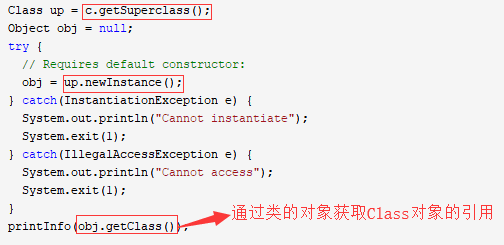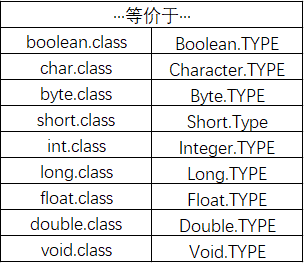Java反射
在运行状态中,对于任意一个类,都能够知道这个类的所有属性和方法;对于任意一个对象,都能够调用它的任意一个方法和属性。
反射主要有两个重要功能:
- 可以通过反射机制发现对象的类型,发现类型的方法、属性、构造器。
- 可以创建对象并访问任意对象方法和属性等。
Class类的实例表示正在运行的Java应用程序的类和接口。
通过Class实例可以获取某个类的属性(Field)、构造器(Constructor)、方法(Method)。
程序可以通过Method对象来执行对应的方法,通过Constructor对象来调用对应的构造器创建实例,能通过Field对象直接访问并修改对象的属性值。
1.反射相关的主要API
- java.lang.Class
- java.lang.reflect.Method
- java.lang.reflect.Field
- java.lang.reflect.Constructor
Class类与java.lang.reflect类库一起对反射的概念进行了支持。该类库包含了Field、Method以及Constructor类(每个类都实现了Member接口)。这些类型的对象是由JVM在运行时创建的。
2.通过反射机制获取类的三种方法
每个类都有一个Class对象。
一旦某个类的Class对象被载入内存,它就被用来创建这个类的所有对象。
2.1 Class.forName()
Class.forName()是取得Class对象的引用的一种方法。
只要你想在运行时使用类型信息,就必须首先获得对恰当的Class对象的引用。
使用Class.forName(),你不需要为了获得Class引用而持有该类型的对象。
class Candy {
static { System.out.println("Loading Candy"); }
}
class Gum {
static { System.out.println("Loading Gum"); }
}
class Cookie {
static { System.out.println("Loading Cookie"); }
}
public class SweetShop {
public static void main(String[] args) {
System.out.println("inside main");
new Candy();
System.out.println("After creating Candy");
try {
Class.forName("Gum");
} catch(ClassNotFoundException e) {
System.out.println("Couldn't find Gum");
}
System.out.println("After Class.forName(\"Gum\")");
new Cookie();
System.out.println("After creating Cookie");
}
}
输出结果:
inside main
Loading Candy
After creating Candy
Loading Gum
After Class.forName("Gum")
Loading Cookie
After creating Cookie
注意:在传递给Class.forName()的字符串中,你必须使用全限定名(包含包名)。
2.2 getClass()
如果你已经拥有一个类型的对象,那就可以通过调用getClass()方法来获取Class引用了。
package typeinfo.toys;
interface HasBatteries {}
interface Waterproof {}
interface Shoots {}
class Toy {
// Comment out the following default constructor
// to see NoSuchMethodError from (*1*)
Toy() {}
Toy(int i) {}
}
class FancyToy extends Toy
implements HasBatteries, Waterproof, Shoots {
FancyToy() { super(1); }
}
public class ToyTest {
static void printInfo(Class cc) {
System.out.println("Class name: " + cc.getName() +
" is interface? [" + cc.isInterface() + "]");
System.out.println("Simple name: " + cc.getSimpleName());
System.out.println("Canonical name : " + cc.getCanonicalName());
}
public static void main(String[] args) {
Class c = null;
try {
c = Class.forName("typeinfo.toys.FancyToy");
} catch(ClassNotFoundException e) {
System.out.println("Can't find FancyToy");
System.exit(1);
}
printInfo(c);
for(Class face : c.getInterfaces())
printInfo(face);
Class up = c.getSuperclass();
Object obj = null;
try {
// Requires default constructor:
obj = up.newInstance();
} catch(InstantiationException e) {
System.out.println("Cannot instantiate");
System.exit(1);
} catch(IllegalAccessException e) {
System.out.println("Cannot access");
System.exit(1);
}
printInfo(obj.getClass());
}
}
输出结果:
Class name: typeinfo.toys.FancyToy is interface? [false]
Simple name: FancyToy
Canonical name : typeinfo.toys.FancyToy
Class name: typeinfo.toys.HasBatteries is interface? [true]
Simple name: HasBatteries
Canonical name : typeinfo.toys.HasBatteries
Class name: typeinfo.toys.Waterproof is interface? [true]
Simple name: Waterproof
Canonical name : typeinfo.toys.Waterproof
Class name: typeinfo.toys.Shoots is interface? [true]
Simple name: Shoots
Canonical name : typeinfo.toys.Shoots
Class name: typeinfo.toys.Toy is interface? [false]
Simple name: Toy
Canonical name : typeinfo.toys.Toy
下面的代码片段就是通过getClass()来获取Class引用的。


Class的newInstance()方法表明:“我不知道你的确切类型,但是无论如何要正确地创建你自己”。
使用newInstance()来创建的类,必须带有默认的构造器。
2.3 使用类字面常量来生成对Class对象的引用(例如 Example.class)
类字面常量不仅可以用于普通的类,也可以应用于接口、数组以及基本数据类型。
对于基本数据类型的包装类,还有一个标准字段TYPE。
TYPE字段是一个引用,指向对应的基本数据类型的Class对象。

当使用“.class”来创建对Class对象的引用时,不会自动地初始化该Class对象。
为了使用类而做的准备工作实际包含三个步骤:
- 加载。这是由类加载器执行的。该步骤将查找字节码(通常在classpath所指定的路径中查找,但这并非是必需的),并从这些字节码中创建一个Class对象。
- 链接。在链接阶段将验证类中的字节码,为静态域分配存储空间,并且如果必需的话,将解析这个类创建的对其他类的所有引用。
- 初始化。如果该类具有超类,则对其初始化,执行静态初始化器和静态初始化块。
初始化被延迟到了对静态方法(构造器隐式地是静态的)或者非常数静态域进行首次引用时才执行。
class Initable {
static final int staticFinal = 47;
static final int staticFinal2 =
ClassInitialization.rand.nextInt(1000);
static {
System.out.println("Initializing Initable");
}
}
class Initable2 {
static int staticNonFinal = 147;
static {
System.out.println("Initializing Initable2");
}
}
class Initable3 {
static int staticNonFinal = 74;
static {
System.out.println("Initializing Initable3");
}
}
public class ClassInitialization {
public static Random rand = new Random(47);
public static void main(String[] args) throws Exception {
Class initable = Initable.class;
System.out.println("After creating Initable ref");
// Does not trigger initialization:
System.out.println(Initable.staticFinal);
// Does trigger initialization:
System.out.println(Initable.staticFinal2);
// Does trigger initialization:
System.out.println(Initable2.staticNonFinal);
Class initable3 = Class.forName("Initable3");
System.out.println("After creating Initable3 ref");
System.out.println(Initable3.staticNonFinal);
}
}
输出结果:
After creating Initable ref
47
Initializing Initable
258
Initializing Initable2
147
Initializing Initable3
After creating Initable3 ref
74
3.获取某个类的所有构造方法
public class ReflectTest1 {
public static void main(String[] args) {
Date date = new Date();
Class cc = date.getClass();
String className = cc.getName();
System.out.println(className);
Constructor[] declaredConstructors = cc.getDeclaredConstructors();
for (Constructor constructor : declaredConstructors) {
int modifiers = constructor.getModifiers();
System.out.print(Modifier.toString(modifiers) + " ");
System.out.print(constructor.getName() + "(");
Class[] paramTypes = constructor.getParameterTypes();
for (Class paramType : paramTypes) {
System.out.print(paramType.getName() + " ");
}
System.out.println(")");
}
}
}
输出结果:
java.util.Date
public java.util.Date(java.lang.String )
public java.util.Date(int int int int int int )
public java.util.Date(int int int int int )
public java.util.Date()
public java.util.Date(long )
public java.util.Date(int int int )
4.获取某个类的所有属性信息
public class ReflectTest2 {
public static void main(String[] args) {
Date date = new Date();
Class cc = date.getClass();
String className = cc.getName();
System.out.println(className);
Field[] fields = cc.getDeclaredFields();
for (Field field : fields) {
String modifiers = Modifier.toString(field.getModifiers());
Class type = field.getType();
String name = field.getName();
System.out.println(modifiers + " " + type.getName() + " " + name);
}
}
}
输出结果:
java.util.Date
private static final sun.util.calendar.BaseCalendar gcal
private static sun.util.calendar.BaseCalendar jcal
private transient long fastTime
private transient sun.util.calendar.BaseCalendar$Date cdate
private static int defaultCenturyStart
private static final long serialVersionUID
private static final [Ljava.lang.String; wtb
private static final [I ttb
5.获取某个类的所有方法信息
public class ReflectTest3 {
public static void main(String[] args) {
Date date = new Date();
Class cc = date.getClass();
Method[] methods = cc.getDeclaredMethods();
for (Method method : methods) {
String modifiers = Modifier.toString(method.getModifiers());
Class returnType = method.getReturnType();
String name = method.getName();
Class[] parameterTypes = method.getParameterTypes();
Class[] exceptions = method.getExceptionTypes();
System.out.println(modifiers + " " + returnType + " " + name
+ "(" + Arrays.asList(parameterTypes) + ")throws" + Arrays.asList(exceptions));
}
}
}
输出结果:
public boolean after([class java.util.Date])throws[]
public boolean before([class java.util.Date])throws[]
public boolean equals([class java.lang.Object])throws[]
public class java.lang.String toString([])throws[]
public int hashCode([])throws[]
public class java.lang.Object clone([])throws[]
public volatile int compareTo([class java.lang.Object])throws[]
public int compareTo([class java.util.Date])throws[]
······
6.动态代理
代理是基本的设计模式之一。
下面是一个用来展示代理结构的简单示例:
interface Interface {
void doSomething();
void somethingElse(String arg);
}
class RealObject implements Interface {
public void doSomething() { System.out.println("doSomething"); }
public void somethingElse(String arg) {
System.out.println("somethingElse " + arg);
}
}
class SimpleProxy implements Interface {
private Interface proxied;
public SimpleProxy(Interface proxied) {
this.proxied = proxied;
}
public void doSomething() {
System.out.println("SimpleProxy doSomething");
proxied.doSomething();
}
public void somethingElse(String arg) {
System.out.println("SimpleProxy somethingElse " + arg);
proxied.somethingElse(arg);
}
}
class SimpleProxyDemo {
public static void consumer(Interface iface) {
iface.doSomething();
iface.somethingElse("bonobo");
}
public static void main(String[] args) {
consumer(new RealObject());
consumer(new SimpleProxy(new RealObject()));
}
}
输出结果:
doSomething
somethingElse bonobo
SimpleProxy doSomething
doSomething
SimpleProxy somethingElse bonobo
somethingElse bonobo
Java的动态代理比代理的思想更向前迈进了一步,因为它可以动态地创建代理并动态地处理对所代理方法的调用。在动态代理所做的所有调用都会被重定向到单一的调用处理器上。
import java.lang.reflect.*;
class DynamicProxyHandler implements InvocationHandler {
private Object proxied;
public DynamicProxyHandler(Object proxied) {
this.proxied = proxied;
}
public Object invoke(Object proxy, Method method, Object[] args) throws Throwable {
System.out.println("**** proxy: " + proxy.getClass() +
", method: " + method + ", args: " + args);
if(args != null)
for(Object arg : args)
System.out.println(" " + arg);
return method.invoke(proxied, args);
}
}
class SimpleDynamicProxy {
public static void consumer(Interface iface) {
iface.doSomething();
iface.somethingElse("bonobo");
}
public static void main(String[] args) {
RealObject real = new RealObject();
consumer(real);
// Insert a proxy and call again:
Interface proxy = (Interface)Proxy.newProxyInstance(
Interface.class.getClassLoader(),
new Class[]{ Interface.class },
new DynamicProxyHandler(real));
consumer(proxy);
}
}
输出结果:
doSomething
somethingElse bonobo
**** proxy: class $Proxy0, method: public abstract void Interface.doSomething(), args: null
doSomething
**** proxy: class $Proxy0, method: public abstract void Interface.somethingElse(java.lang.String), args: [Ljava.lang.Object;@53bd815b
bonobo
somethingElse bonobo
通过调用静态方法Proxy.newProxyInstance()可以创建动态代理,这个方法需要得到一个类加载器。
动态代理可以将所有调用重定向到调用处理器,因此通常会向调用处理器的构造器传递给一个“实际”对象的引用,从而使得调用处理器在执行其中任务时,可以将请求转发。
7.空对象
当你使用内置的null表示缺少对象时,在每次使用引用时都必须测试其是否为null,这显得枯燥,而且势必产生相当乏味的代码。问题在于null除了在你试图用它执行任何操作来产生NullPointerException之外,它自己没有其他任何行为。有时引入空对象的思想将会很有用,它可以接受传递给它的所代表的对象的消息,但是将返回表示为实际上并不存在任何“真实”对象的值。通过这种方式,你可以假设所有的对象都是有效的,而不必浪费编程精力去检查null。
推荐阅读:java设计模式之空对象模式
8.接口与类型信息
interface关键字的一种重要目标就是允许程序员隔离构件,进而降低耦合性。如果你编写接口,那么就可以实现这一目标,但是通过类型信息,这种耦合性还是会传播出去——接口并非是对解耦的一种无懈可击的保障。
package typeinfo.interfacea;
public interface A {
void f();
}
import typeinfo.interfacea.*;
class B implements A {
public void f() {System.out.println("B.f()");}
public void g() {System.out.println("B.g()");}
}
public class InterfaceViolation {
public static void main(String[] args) {
A a = new B();
a.f();
// a.g(); // Compile error
System.out.println(a.getClass().getName());
if(a instanceof B) {
B b = (B)a;
b.g();
}
}
}
通过使用RTTI(Run-Time Type Identification),我们发现a是被当做B实现的。通过将其转型为B,我们可以调用不在A中的方法。
对实现使用包访问权限,这样在包外部的客户端就不能看到它了:
package typeinfo.packageaccess;
import typeinfo.interfacea.*;
class C implements A {
public void f() { System.out.println("public C.f()"); }
public void g() { System.out.println("public C.g()"); }
void u() { System.out.println("package C.u()"); }
protected void v() { System.out.println("protected C.v()"); }
private void w() { System.out.println("private C.w()"); }
}
public class HiddenC {
public static A makeA() { return new C(); }
}
现在如果你试图将A向下转型为C,则将被禁止,因为在包的外部没有任何C类型可用:
import typeinfo.interfacea.*;
import typeinfo.packageaccess.*;
import java.lang.reflect.*;
public class HiddenImplementation {
public static void main(String[] args) throws Exception {
A a = HiddenC.makeA();
a.f();
System.out.println(a.getClass().getName());
// Compile error: cannot find symbol 'C':
/* if(a instanceof C) {
C c = (C)a;
c.g();
} */
// Oops! Reflection still allows us to call g():
callHiddenMethod(a, "g");
// And even methods that are less accessible!
callHiddenMethod(a, "u");
callHiddenMethod(a, "v");
callHiddenMethod(a, "w");
}
static void callHiddenMethod(Object a, String methodName) throws Exception {
Method g = a.getClass().getDeclaredMethod(methodName);
g.setAccessible(true);
g.invoke(a);
}
}
输出结果:
public C.f()
typeinfo.packageaccess.C
public C.g()
package C.u()
protected C.v()
private C.w()
如果你知道方法名,你就可以在其Method对象上调用setAccessible(true)。
没有任何方式可以阻止反射到达并调用那些非公共访问权限的方法。对于域来说,的确如此,即便是private域。
import java.lang.reflect.*;
class WithPrivateFinalField {
private int i = 1;
private final String s = "I'm totally safe";
private String s2 = "Am I safe?";
public String toString() {
return "i = " + i + ", " + s + ", " + s2;
}
}
public class ModifyingPrivateFields {
public static void main(String[] args) throws Exception {
WithPrivateFinalField pf = new WithPrivateFinalField();
System.out.println(pf);
Field f = pf.getClass().getDeclaredField("i");
f.setAccessible(true);
System.out.println("f.getInt(pf): " + f.getInt(pf));
f.setInt(pf, 47);
System.out.println(pf);
f = pf.getClass().getDeclaredField("s");
f.setAccessible(true);
System.out.println("f.get(pf): " + f.get(pf));
f.set(pf, "No, you're not!");
System.out.println(pf);
f = pf.getClass().getDeclaredField("s2");
f.setAccessible(true);
System.out.println("f.get(pf): " + f.get(pf));
f.set(pf, "No, you're not!");
System.out.println(pf);
}
}
输出结果:
i = 1, I'm totally safe, Am I safe?
f.getInt(pf): 1
i = 47, I'm totally safe, Am I safe?
f.get(pf): I'm totally safe
i = 47, I'm totally safe, Am I safe?
f.get(pf): Am I safe?
i = 47, I'm totally safe, No, you're not!
但是,final域实际上在遭遇修改时是安全的。运行时系统会在不抛出异常的情况下接受任何修改尝试,但是实际上不会发生任何修改。

